Garden Glimpses: An Ant’s-Eye Equinox
Spring first unfurls in the garden, not in sweeping vistas, but dots of color punctuating winter’s drab. A snowdrop emerges and glistens pristine white from a mulched bed; a crocus spreads its vibrant yellow blossom widely in response to the waxing sun, its bladed leaves slicing through the encroaching straw-colored grassy turf at the path’s edge. Vivid green tips of mid-season daffodils rise upward in hopeful aspiration, massed in patches across the landscape. The initial change of seasons is emphatic, but lost in panorama; it’s best viewed up close, at the level of the perforated earth, in much the way a passing ant might see it.


The show began in late February, and by the Vernal equinox, three weeks later, was well underway. Pale blue crocus came first, with snowdrops close behind. Snow crocus, in shades of white tinged purple beneath, creamy butter yellow, and lemon streaked with purple-brown followed. Then winter aconite, subtly invisible until it bursts into vivid buttercup yellow blossoms on short, ferny-fringed stems, dazzling spots of sunshine in the garden.

Promise is everywhere: in the spreading octopus-like emergence of muscari leaves, stretching from a bud-beaked center into writhing tentacles of bluish green; the budding diminutive tete-a-tete daffodils, first narcissus to open; greening groundcover archangel’s sparkling silver ribs; native aster sprouting at the base of last year’s spent woody stalks.
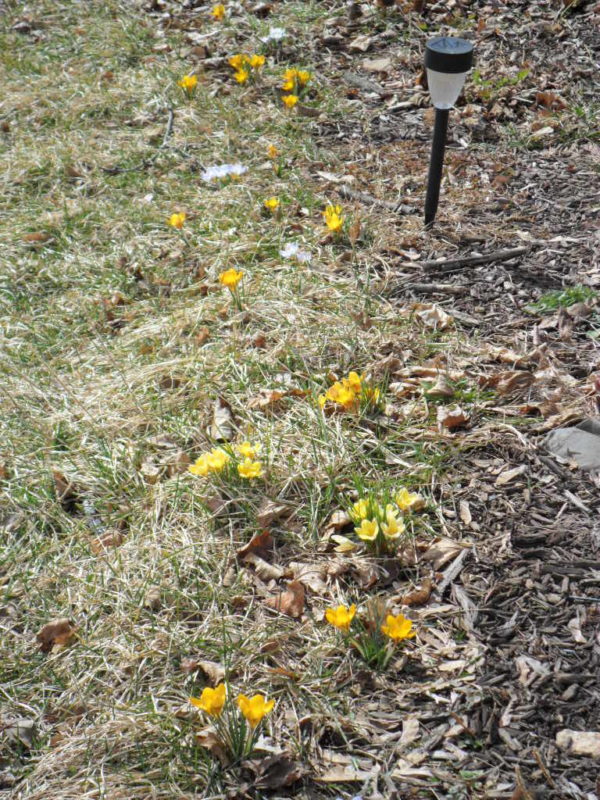



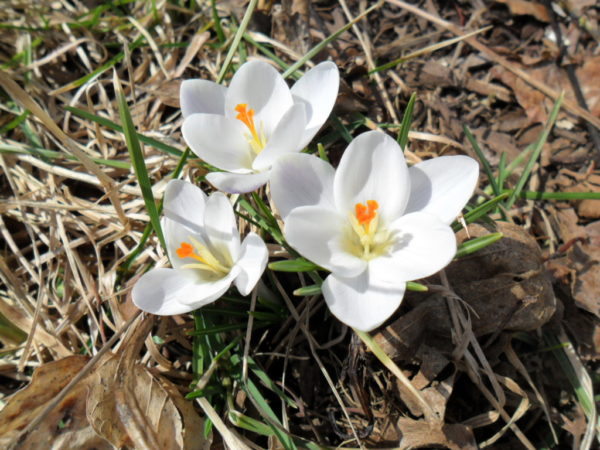
Scilla mischtschenkoana, AKA “Striped Squill”, suddenly leaps into life with its masses of starlike blooms, pure white ribbed with palest blue, clustered on four-inch stalks, a striking counterpoint to violet iris reticulata and the later-blooming purple crocus. Combining their colors is Pickwick, a giant crocus cultivar in white with purple streaks whose patch looks like a huge solid bouquet of blossoms, so thickly do they flower.


The trees are still bare, stark against an azure sky smeared with streaks of cloud, but a few days of unseasonable warmth sets birch and maple buds to swelling. Soon they’ll burst open, dangling yellow catkins like so many arboreal annelids, or peppered with fireworks of minuscule chartreuse blossoms.
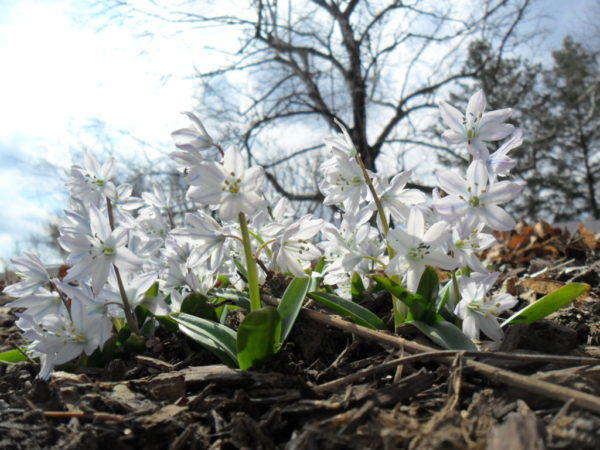
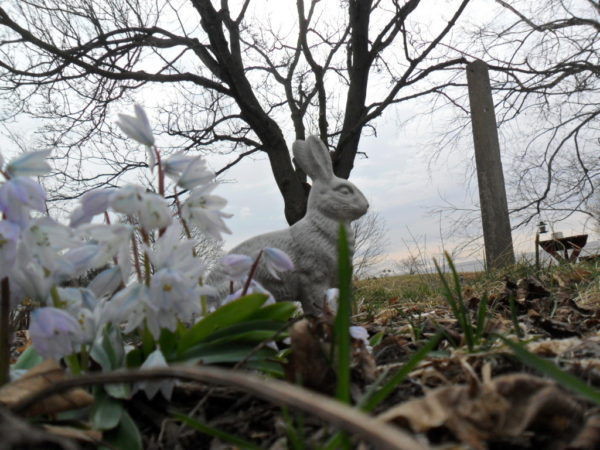
Woodland perennials are beginning to stir as well. Trilobed trillium luteum (with the delightful common name of Wake-robin!) unfolds its mottled green and brown leaves, woodruff sends up delicate new whorls, and corydalis solida Beth Evans quickly sets buds among its bleeding-heart-like medium green foliage, soon to be studded with coral pink tubular blossoms. Bicolored brunnera is warming up in the bullpen, and before long will grace the garden with its clusters of bright blue forget-me-not-like flowers. The two new patches of stylophorum diphyllum (Celandine poppy) planted last spring have yet to bloom, but are returning in strength, causing me to hope for some bright yellow four-petaled flowers in due course come May.
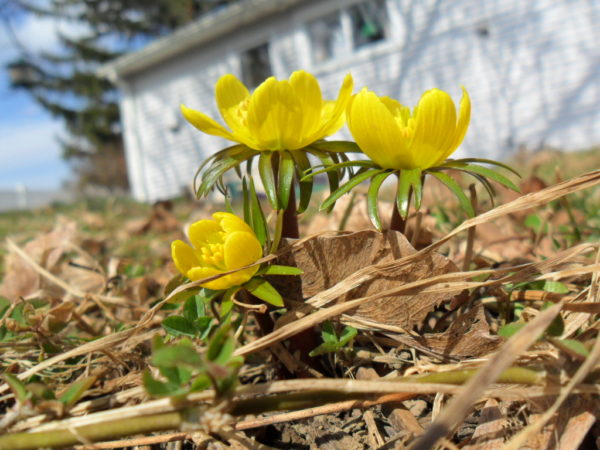
Spring-flowering shrubs and trees are typically later, but the new witch hazel began to blossom in mid-February, and provided a full month of golden glory until an early heat wave pushed it past the limit just before the equinox. By then, the forsythia was coming into its own, though it had already graciously surrendered itself in cuttings which I had been bringing indoors and forcing weekly since the end of January. Forsythia blooms on old wood, and my father’s habit of keeping it trimmed into a small ball structure throughout the growing season had stymied its natural vigor for years, limiting its spring performance. Released from this hindrance with my inheritance of the property, the forsythia has responded with such exuberance that I’ve been able to cull massive bouquets, without doing the plant any harm whatsoever. After it has bloomed out, I won’t touch it again until next winter’s doldrums set me scurrying for an advanced bit of spring.
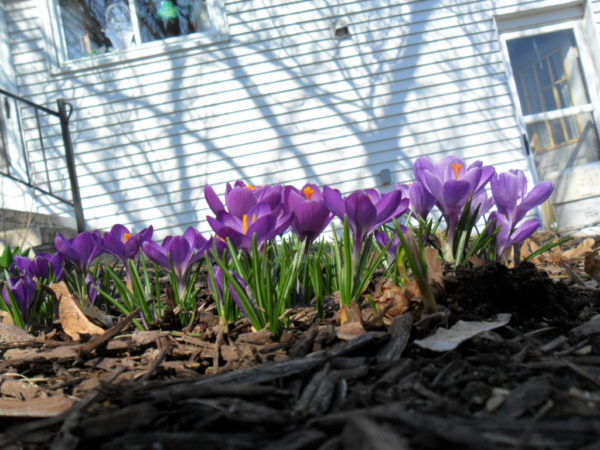

The birds are still with us as well. Flocks of Canada and snow geese arc overhead, in seemingly endless parade, returning to their summer abodes up north. These honking hordes are an auditory reminder of the arrival of spring. Less welcome migrators are the grackles, who invade the bird feeders in droves, crowding out the local avian populations. Their iridescent teal throats emit raucous twangs calling their fellows to the feast. About the only time they’re silent is when pairs of wide-winged hawks glide in ever-expanding circles across the yard, causing the grackles to retreat into the protective cover of the neighbor’s evergreens, while smaller sparrows, finches and juncos flit deeper into the massive stand of lilacs, secure in its enmeshed twigs. Lilac buds are starting to swell now also, their lime-green mounds separating into miniscule flower heads and encapsulating leaves.


Of course the main harbinger of the season is the red-breasted robin, hopping his bobbing dance across the sandmound in search of an earthworm breakfast amidst the newly-thawed earth. As the old adage goes, it’s the early bird that gets that worm, and these robins are up and doing with the dawn every morning. After a satisfying repast, Cock Robin will come sing a snatch or two of song from a branch of the maple outside the kitchen window, heralding another new day.


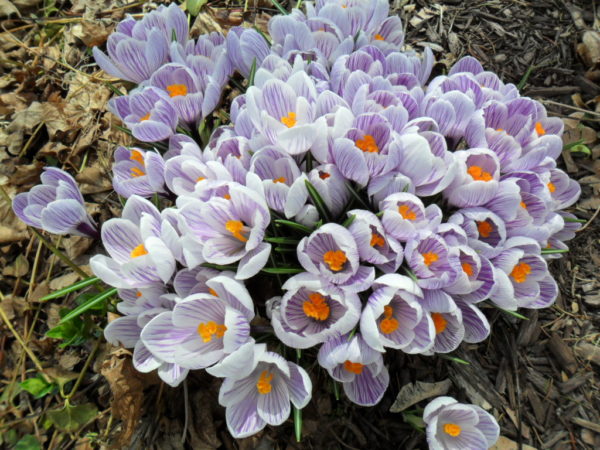
As more and more blossoms yield to the sun’s warmth, early pollinators can be seen as well. I was privy recently to a solitary bumblebee, poking his head into the tiny trumpets of an early stand of tete-a-tete mini daffodils, wriggling all the way in to the base, then extricating himself with awkward retrograde grace before moving on to the next bloom.
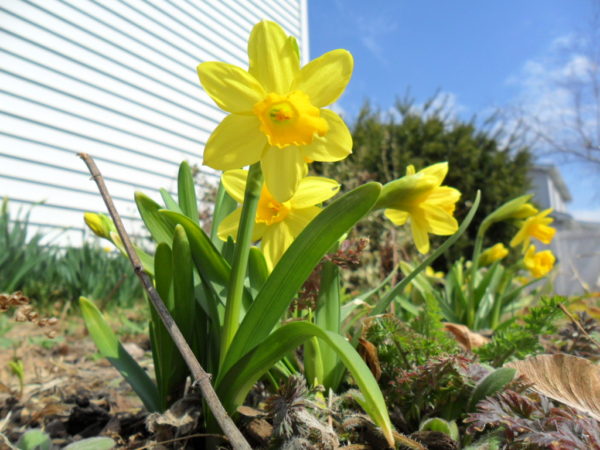
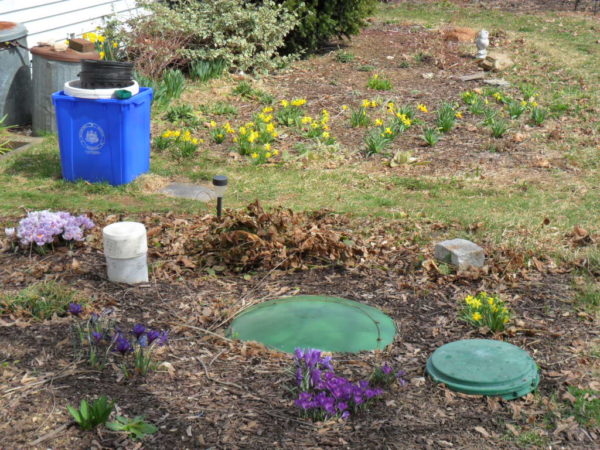
As noted, tete-a-tetes are among the first narcissus varieties to flower; mine began a week before the equinox, in groupings closest to the house, where conditions are warmer; then a burst of early heat set them blooming across the yard. A phalanx of mini Jetfire narcissus punctuates the main tete-a-tete bed, a slightly larger, taller variety with orange cups and windswept yellow petals, which typically opens within days of its smaller cousin. An older planting of bright yellow standard-sized daffodils right next to the house, left by my parents, also blooms early, but in the main my narcissus are of the mid- to late-season variety. Some are thickly budded now, others are barely emerging from the soil, but, depending on weather conditions, these should provide bloom throughout April and into early May.
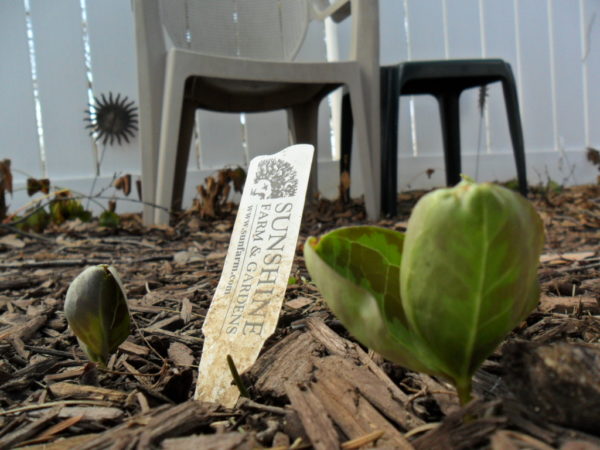
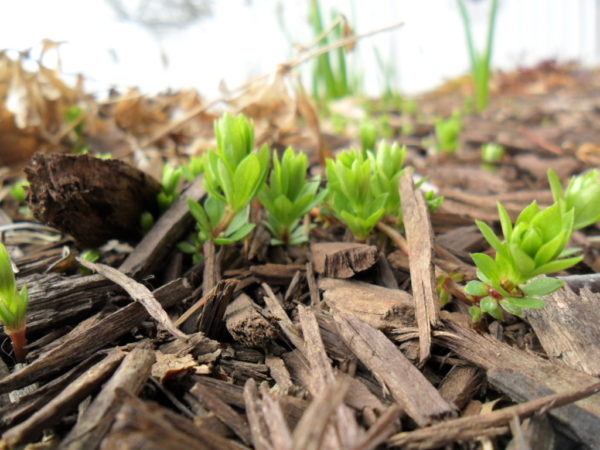
Muscari, or grape hyacinth, will be coming into their own before too long as well, with the deep blue of traditional bluebells, augmented by varieties in white, pale blue, pink, yellow-green, and an eye-catching tricolored cultivar, combining layers of deep blue, pale blue and white in one blossom.


Muscari’s full-blooded cousin, the hyacinth, is also starting to bud, scattered in small patches across the garden. Some are the standard blue, but there are others in various shades of pink, white, pale yellow, apricot and deepest mauve; these should begin to flower within a few weeks.
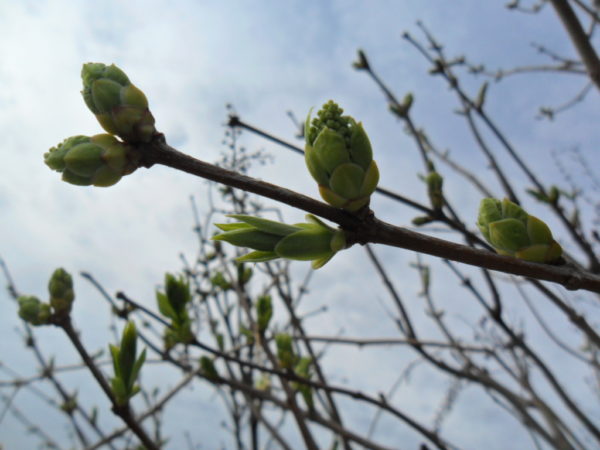
I haven’t planted tulips, which require more work over the years to lift and divide the bulbs for best bloom, but there are a few remaining of what my parents had, in a rainbow of colors, though not very prolific. These will be among the last of my 1800+ spring bulbs to bloom, along with the multi-flowered Leucojum, with its delicate bell-shaped, downturned blossoms, white with green dots at the petal terminus, six or eight to a stem.

Now that the show has begun, it will increase in pace and intensity, so check in for your garden tour frequently; we’re always open!
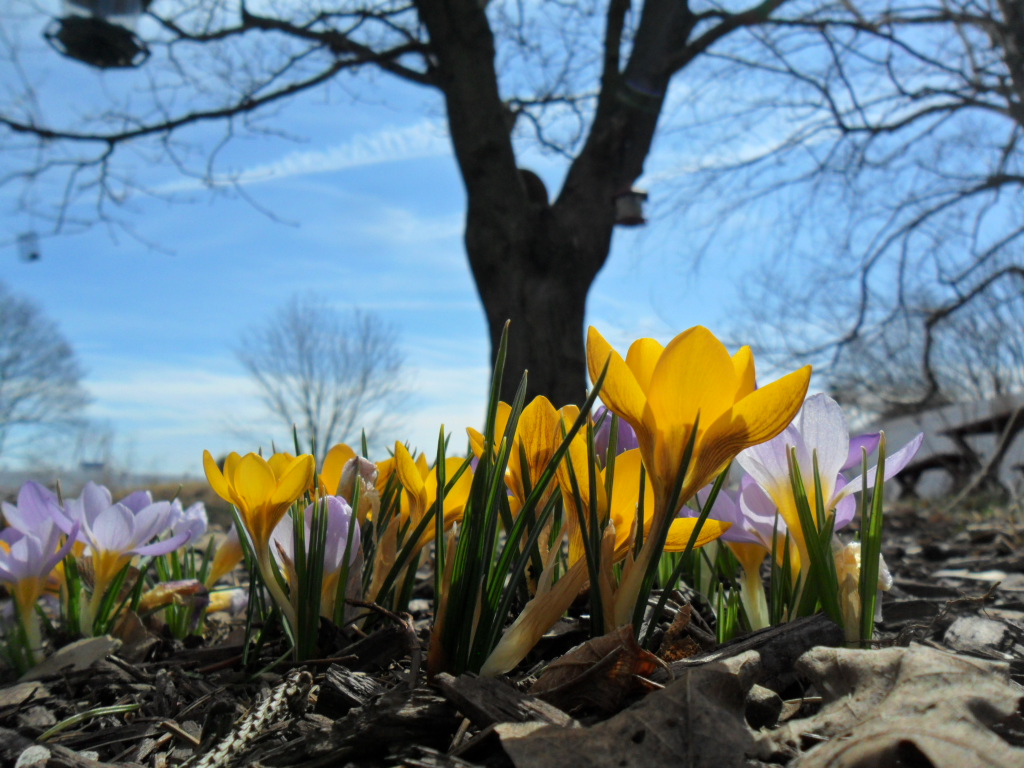

One comment, add yours.
Laurien
Loved the crocus photos, Alex! The voles eat any crocus bulbs we plant here but they do leave alone our scilla so we have some of that coming up. Enjoyed seeing the grackles too that we don’t get on this side of the continent. Thanks Alex, and happy gardening!